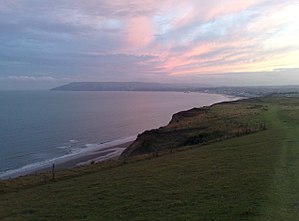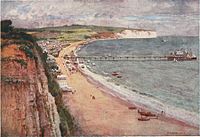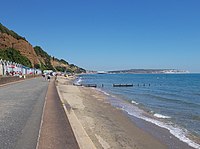Sandown Bay: Difference between revisions
Created page with "right|thumb|300px|Sandown Bay at dusk from Culver Down {{county|Hampshire}} '''Sandown Bay''' is a broad open bay which stretches for much of the leng..." |
|||
| Line 34: | Line 34: | ||
{{reflist}} | {{reflist}} | ||
[[Category:Bays of | [[Category:Bays and inlets of Hampshire]] | ||
Latest revision as of 20:39, 28 July 2022

Sandown Bay is a broad open bay which stretches for much of the length of the south-east coast of the Isle of Wight in Hampshire. The bay extends for eight and a half miles from Culver Down, near Yaverland in the north-east of the Island, to just south of Shanklin, near the village of Luccombe in the south-west.
At Luccombe, the bay is separated from the Undercliff by a large headland from which Upper Ventnor sits atop. The towns of Shanklin, Lake and Sandown are on the bay's coast, while Luccombe and Upper Ventnor feature panoramic views across both Sandown Bay to the East and the Undercliff to the southwest. Due to the bay being relatively sheltered from offshore winds it is often used as temporary anchorage point for boats,[1] including large cargo ships, before continuing east towards Europe, or north towards The Solent.
History

In the past, the bay had significant military importance as the wide beach offered a good landing-point for an armed invasion of the Island. To protect against a French or Spanish invasion, Henry VIII built Sandown Castle in the centre of the bay as part of his chain of coastal defences to protect the south coast. However, the castle was still under construction during the French invasion of the Isle of Wight of 1545 when it was overwhelmed.[1] This castle fell into disrepair due to coastal erosion and was demolished in 1631, though the remains of the foundations of the castle are still visible along the shore at low tide.[2] Sandown Fort, also known as the Diamond Fort after its arrow-headed bastions, this was built using the remains of the old castle further up the coast.[1]
As a result of its sandy beach and good weather, Sandown and Shanklin grew rapidly in the Victorian era as tourists from across both the Island and the country came to enjoy the seaside thanks to new the transportation connections of the railway and paddle steamers. This transformed a relatively sparsely populated area into a series of bustling seaside resorts. New developments included a long promenade, many large seafront hotels and the 875 foot Sandown Pier (originally 360 ft when opened in 1879).[3] A great deal of Victorian-influenced architecture can still be seen along the shore of the bay.
Geography

Sandown Bay is an excellent example of a concordant coastline and has well-developed sandy beaches stretching all the way from Shanklin to Culver Down due to Longshore drift.[4] The bay has over 5 miles of unbroken sandy beach, making it one of the longest beaches in the British Isles.[5] The area has weak sandstone cliffs which vary from 30 to 130 feet, these have suffered from erosion and instability in the past.
The bay is best viewed from Culver Down to the north. The Isle of Wight Coastal Path follows the whole bay-line either along the cliff top to the south of Sandown or the concrete seawall north of Sandown.[6]
The bay itself has a seabed consisting of a mixture of sand, shells and gravel with shallow waters out to about a quarter of a mile.[1] The total area of the bay is five square miles .[5]
Economy and tourism
The economy of the bay is dominated by retail and hospitality sectors due to a large amount of tourism it receives, an estimate of 500,000 visitors annually.
Maritime incidents
The outer bay is used as a sheltered anchorage. Ships requiring salvage have sometimes been towed there, such as the tanker Tarpenbeck in 1979. The wreck of a salvage tug (the Harry Sharman) which assisted the stricken tanker Pacific Glory in 1970,[7] was visible for some decades at low tide below Culver Cliffs.
Location
- Location map: 50°38’36"N, 1°9’34"W
Outside links
References
- ↑ 1.0 1.1 1.2 1.3 "Sandown Bay". https://eoceanic.com/sailing/harbours/457/. Retrieved 5 September 2018.
- ↑ William Page, ed (1912). "Parishes: Brading". British History Online. http://www.british-history.ac.uk/vch/hants/vol5/pp156-170. Retrieved 20 June 2015.; "Sandown Castle". Historic England. http://www.pastscape.org/hob.aspx?hob_id=461937.; Adams 1884, p. 200
- ↑ "Sandown Pier". National Piers Society. https://www.piers.org.uk/pier/sandown-culver/. Retrieved 4 September 2018.
- ↑ "Isle of Wight Shoreline Management Plan 2". Isle of Wight Council. December 2010. http://www.coastalwight.gov.uk/smp/FINAL_SMP_for_web/pdf_Appendices/AppendixC/Appendix_C3_BaselineScenarios_Dec10_Final.pdf.
- ↑ 5.0 5.1 "Coastal Communities Economic Plan, Sandown Bay". Coastal Communities Alliance. May 2016. https://www.coastalcommunities.co.uk/wp-content/uploads/2016/05/Sandown-Bay-CCT-Economic-Plan.pdf.
- ↑ "Coastal Path Sandown to Ryde". https://www.visitisleofwight.co.uk/dbimgs/5.Sandown-Ryde.pdf.
- ↑ [1] Isle of Wight History and Heritage, the Pacific Glory